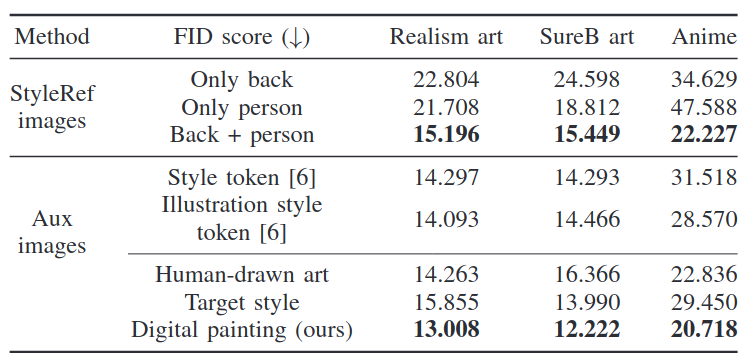StyleBoost: A Study of Personalizing Text-to-Image Generation in Any Style using DreamBooth
International Conference on Information and Communication Technology Convergence (ICTC), 2023
Posted by : Junseo Park on
Category : conference

🚀 "Style Personalizing in Text-to-Image Synthesis
using DreamBooth" 🌟
using DreamBooth" 🌟
Context
- Recent advancements in text-to-image models, such as Stable Diffusion, have demonstrated their ability to synthesize visual images through natural language prompts.
- DreamBooth is a recent method for personalization of pre-trained text-to-image diffusion model, such as Stable Diffusion, using only a few images of a specific object, called instance images.
- Using $3 − 5$ images of the specific object (e.g., my dog) paired with a text prompt (e.g., “A [V] dog”) consisting of a unique token identifier (e.g., “[V]”) representing the given object (i.e., my dog) and the corresponding class name (e.g., “dog”), DreamBooth fine-tunes a text-to-image diffusion model to encode the unique token with the subject.
- To this end, DreamBooth introduces a class-specific prior preservation loss that encourages the fine-tuned model to keep semantic knowledge about the class prior (i.e., “dog”) and produce diverse instances of the class (e.g., various dogs).
- Loss proposed by DreamBooth
- $\mathbf{x}$: ground-truth image for text prompt (e.g., “A [V] dog”)
- $\mathbf{c}$: conditioning vector (e.g., obtained from “A [V] dog”)
- $\epsilon, \epsilon’$: Gaussian noise
- $\mathbf{x}_{\text{pr}}$: ground-truth image for class prior (e.g., “dog”)
- $\mathbf{c}_{\text{pr}}$: conditioning vector for class prior prompt (e.g., obtained from “dog”)
- $\alpha_t, \alpha_t’, \sigma_t, \sigma_t’, w_t, w_t’$: terms that control noise schedule and sample quality

Problem
- DreamBooth’s personalization capabilities are excellent, especially for clear subjects like objects. However, learning to generate images that encapsulate various art styles remains a challenging problem due to the abstract and broad visual perceptions required for stylistic attributes such as lines, shapes, textures, and colors.
- In this paper, we aim to inherit DreamBooth’s personalization abilities while effectively binding the abstract concept of “art style.”
- Instance prompt/images $\rightarrow$ StyleRef prompt/images
- Class prior prompt/image $\rightarrow$ Aux prompt/images
Proposed Method
- We hypothesize that DreamBooth struggles to learn abstract concepts due to the following reasons:
- StyleRef prompt (e.g., “A [V] style”) and Aux prompt (e.g., “style”) share the same token, and as a result, they influence each other during the learning process.
- During learning, to prevent the Aux prompt (e.g., “style”) from being lost, the Aux prompt is provided to generate images, and the corresponding token is re-learned. However, the pre-trained model has learned the Aux prompt as referring to fashion style, which is not useful for learning the target style.
- To address this, we propose the following method:
- Aux images are carefully selected to represent art works and people that are related to the target style, rather than fashion styles (high-resolution images).
- Detailed descriptions of people (e.g., hands, legs, face, and full-body shots) remain important for qualitative evaluation, while landscapes or animal images are less sensitive. Therefore, Aux images mainly consist of portraits and/or images of people. This helps in generating high-quality images for people-related prompts.
- Since learning style from only $3 - 5$ images is difficult, we proceed with training using around $15 - 20$ images.
- Our approach uses around $15 - 20$ images for both StyleRef and Aux images, establishing a foundational binding of the unique token identifier with a broad range of the target style. The Aux images are carefully chosen to strengthen this binding. This dual-binding strategy helps capture the essential concept of art styles and accelerates the learning of the diverse attributes of the target style.
- Aux images are carefully selected to represent art works and people that are related to the target style, rather than fashion styles (high-resolution images).
- Aux images ablation for three target styles, displaying FID and CLIP scores.

Result
- Experimental evaluation on three styles—realism art, SureB art, and anime—demonstrates significant improvements in both the quality of generated images and perceptual fidelity metrics, such as FID and CLIP scores.
- “StyleRef”: The composition of the target image should appropriately mix people and backgrounds to comprehensively understand the target style.
- “Aux”: The Aux images should be composed in a style that can assist the target style.
